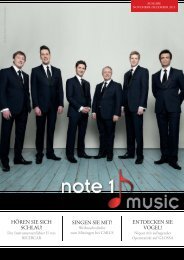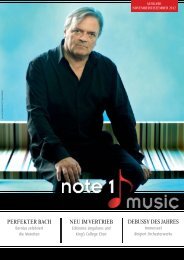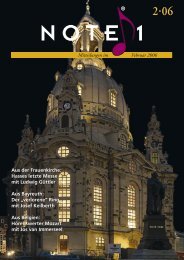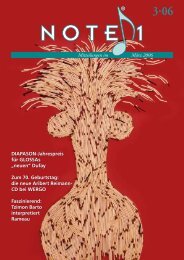S. Kuijken Cantatas for the complete Liturgical ... - Euroton Musik AB
S. Kuijken Cantatas for the complete Liturgical ... - Euroton Musik AB
S. Kuijken Cantatas for the complete Liturgical ... - Euroton Musik AB
Create successful ePaper yourself
Turn your PDF publications into a flip-book with our unique Google optimized e-Paper software.
For several years, we<br />
have chosen to per<strong>for</strong>m<br />
<strong>the</strong> vocal works of J. S. Bach<br />
(<strong>Cantatas</strong>, Motets, Passions<br />
etc.) with vocal <strong>for</strong>ces of one<br />
singer to a part, and not with<br />
a “choir“ in <strong>the</strong> usual sense.<br />
Indeed, some well-founded<br />
musicological studies,<br />
started nearly a quarter of<br />
a century ago by Joshua Rifkin, demonstrated that<br />
Bach – as well as his contemporaries – was used to<br />
composing his “modern“ music <strong>for</strong> per<strong>for</strong>mance by<br />
such a vocal quartet. So, in <strong>the</strong> <strong>Cantatas</strong>, Passions,<br />
Magnifi cat and Masses, <strong>the</strong>se “per<strong>for</strong>mers“ would<br />
have to sing everything that appeared in <strong>the</strong> score: <strong>the</strong><br />
recitatives, <strong>the</strong> arias, <strong>the</strong> chorales and <strong>the</strong> ensembles<br />
(choruses). Thus <strong>the</strong> works <strong>for</strong> double choir (certain<br />
Motets, <strong>the</strong> St. Mat<strong>the</strong>w Passion) had to have eight<br />
singers. This corresponds exactly with Bach‘s kind of<br />
writing. Even if <strong>the</strong>re exist nowadays choirs of reduced<br />
size, which can perfectly overcome <strong>the</strong> technical<br />
diffi culties posed by Bach‘s scores, it seems to me more<br />
and more that <strong>the</strong> practice of tripling and quadrupling<br />
<strong>the</strong> vocal <strong>for</strong>ces in Bach‘s works is comparable to<br />
playing a Haydn quartet with 16 musicians. Certainly<br />
“realizable“, but less appropriate to <strong>the</strong> actual essence<br />
of <strong>the</strong> work‘s writing. In <strong>the</strong> version with “soloists“,<br />
<strong>the</strong> whole can remain transparent, and yet “inhabited“<br />
by <strong>the</strong> individual contributions of <strong>the</strong> four singers.<br />
A certain “madrigalism“ can be detected, which<br />
hardly corresponds to a “choral“ per<strong>for</strong>mance. The<br />
instrumental <strong>for</strong>ces are also those suggested by<br />
Bach, and are those found every time in <strong>the</strong> original<br />
material which comes down to us. Needless to say, <strong>the</strong><br />
10<br />
per<strong>for</strong>mance without a “conductor“, in <strong>the</strong> “modern“<br />
sense, is vital from this point of view, and thus <strong>the</strong><br />
creation of <strong>the</strong> moment becomes more than ever a<br />
shared and essential act by all <strong>the</strong> participants. The<br />
programme presented here is part of a vast project,<br />
spread over many years. Indeed, we have undertaken<br />
<strong>the</strong> realization of a <strong>complete</strong> liturgical year of <strong>Cantatas</strong>.<br />
This will result in about 20 CDs, bringing toge<strong>the</strong>r <strong>the</strong><br />
<strong>Cantatas</strong> <strong>for</strong> every Sunday and <strong>the</strong> great Festivals<br />
of <strong>the</strong> liturgical year. We will give <strong>the</strong>m in groups<br />
of three or four <strong>Cantatas</strong>, wherever possible in <strong>the</strong><br />
appropriate period of <strong>the</strong> year.<br />
Sigiswald <strong>Kuijken</strong>, 15 December 2005<br />
Depuis quelques années, nous avons choisi de<br />
présenter les œuvres vocales de J.S. BACH (Cantates,<br />
motets, passions, ...) avec un effectif vocal d’un chanteur<br />
par partie, et non pas avec un « chœur » au sens habituel.<br />
Des études musicologiques très fondées, initiées il y a<br />
bientôt un quart de siècle par Joshua Rifkin, démontrent<br />
en effet que Bach (ainsi que ses contemporains)<br />
était habitué de concevoir sa musique « moderne »,<br />
concertante pour un tel quatuor vocal. Ceci correspond<br />
parfaitement à la nature même de l’écriture de Bach :<br />
même s’il existe de nos jours des « chœurs » de taille<br />
réduite, qui arrivent parfaitement à vaincre les diffi cultés<br />
techniques posées par les partitions de Bach, je me sens<br />
de plus en plus convaincu que la pratique de tripler ou<br />
quadrupler l’effectifvocal dans les œuvres de Bach soit<br />
comparable à l’exécution d’un quatuor de Haydn à 16<br />
musiciens... Certes « réalisable », mais moins appropriée<br />
à l’essence même de l’écriture de l’œuvre.
















